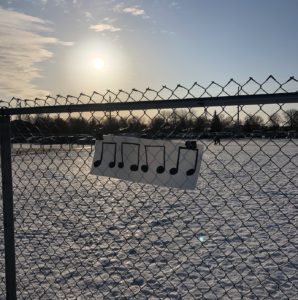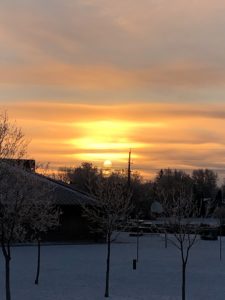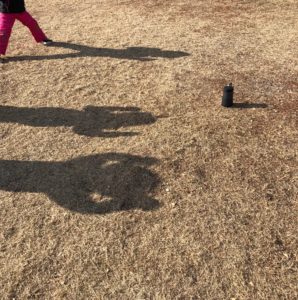Learning Music Outside

To view the photo-rich magazine version, click here.
Originally appears in the Summer 2021 issue.
By Jennifer Engbrecht
It’s 8:30 a.m. on a frosty January morning as students dash out to their music class area to start the day, dancing a familiar warm-up. I am dancing with them, but distracted by the view, I climb up the hill next to us as they continue dancing. I stop the music and call to them: “Come up here and watch this amazing sunrise!” The students all come running up the hill, enjoying both the sunrise on one side and the moon on the other in the early morning prairie sky. “It looks like The Lion King,” exclaims one student. This inspires me to find the music for “The Circle of Life” on my device, while we all fly, prance, and move around like various animals from the opening of The Lion King, laughing and swirling around in the wide open field. Later, they dance-walk back to their classroom teacher to continue learning inside, followed by a video of the Broadway version of “The Circle of Life” that I have sent to their classroom teacher for continued learning of a musical genre they just enjoyed.
Impromptu moments like these are peppered throughout our days in our outdoor music classroom at École St. Germain, in the Louis Riel School Division in Winnipeg, Manitoba, Canada. Beyond simply taking traditional music classes outside, we also follow the inspiration of our surroundings and unplanned visits by local wildlife, or of natural events that cause us to stop and marvel at the environment around us. I teach Grade 2 through 5. I have a teaching partner for part of each day, who teaches Kindergarten and Grade 1 students. What follows is how our outdoor music adventure started, as well insights on what worked and reflections on what we learned.
Move. Play. Create. Inspire.
My vision for outdoor music learning is “Move. Play. Create. Inspire.” I try to incorporate this vision into every learning experience. This year, students have had somewhat limited movement inside schools because of the need for remaining distanced. This also can limit the types of learning activities inside, as group work can be difficult to manage with distancing. Because of this, when we are outside and have the space, we can spread out much more, and have more space to create music or movement responses to music.
This vision for outdoor learning developed over time this past year. Our outdoor music learning began as a way to facilitate distancing throughout the school during the time of COVID-19, and to have fresh-air opportunities outside. I had spent time during the summer months researching how to go about teaching music outside, so when this option was offered as a possibility just before school started in September, I was very excited to try this new way of engaging with this subject that I love.
The beginning
At first, I started with what I knew: sharing folkdances. Every year for decades, our school division has held a special event called Folkdance in the Park, which we had to miss as an in-person event in the spring of 2020, as students were learning from home. Students were alternately offered a live Folkdance at Home event, which was fine, but the opportunity to share these dances outside in the fall, in person, was well received.
I didn’t want teaching outside to simply be taking indoor activities outside. In a lot of ways, trying to recreate indoor music classes outside would have been difficult, due to the restrictions. Singing was highly recommended in a study of performing arts out of Colorado State University. To use instruments would have required either sanitizing between classes or using individual instrument kits. The former would have been problematic, as we had no time between classes, and the latter would have had us creating kits out of single-use plastics that could potentially have ended up in a landfill within the year. While these challenges are surmountable, and are being overcome with success elsewhere, I chose to focus on trying new ideas that did not have such challenges. I chose to find new ways to engage with music.
For the first while, several lessons I had planned revealed themselves to be awkward outside. At certain times, I would be outside, about to start a lesson, and then I would realize that an idea was not going to work. Changes would happen on the spot, and we would go in a different direction.
Using movement (dance) and drama to demonstrate music concepts became important integrations, as the arts lend themselves quite well to music; music is only “musical” when enhanced by our emotions and movement, which bring energy to the music. Day by day, I would think of different ways to use movement and drama in an outdoor environment to demonstrate musical understanding of meter, rhythm, musical expression, and form. An example would be taking a musical selection that has a form such as ABA (e.g., with A being a slow section and B being a faster section) and using movement or drama to demonstrate the style of the contrasting sections either through slow/fast movements, or using drama to show the contrasting moods. An example of this is Haydn’s Symphony 101 (“The Clock”), in which there is a dramatic difference about a minute or so into the piece. Students can create scenarios for the first section, then show what happens to those characters and scenes when the music becomes quite dramatic. Such fun creative ideas are imagined by each group! An example of using movement to demonstrate rhythms would be creating workout exercises from rhythms. This could be a mix of jumping jacks, high-knee running, or even mountain climbing.

The transformation
Experiencing music outside began to change the way I saw learning. This occurred through teachable moments of nature revealing itself. For example, we were in the middle of a lesson when an eagle flew above us. We all stopped and watched it circling. I had a recording of myself singing the “Eagle Song” in Ojibwe that a class and I had learned a few years earlier as a teaching from a representative of the school division Indigenous learning team. We listened to the song, spoke of the seven teachings we had learned, and did a (distanced) round dance. Other times, when we would see geese flying over, I would bring up the Barenaked Ladies song “Here Come the Geese” and we would put ourselves in a distanced V formation and “fly” across the field ourselves! One time it had just snowed, so the class that was outside with me took this special moment of having fresh, untouched snow, and we carefully walked across the field making our own footprint art while listening to Debussy’s “Des pas sur la neige.” Another time, I noticed during another teacher’s class that students were curious about their shadows, so I followed up on this curiosity with my next classes, and we watched as our shadows demonstrated the phrases in Satie’s “Gymnopédie.” It is so fun to not only dance, but to get to watch your own dance right in front of you with your shadow! It’s like performing and being an audience member all at the same time!

None of these unique experiences could ever have happened during our indoor music classes, and we have been thrilled to see where all of these ideas have been leading us this year! I learned, while listening to Disconnect: the Outdoor Education Podcast with Joël Charrière, when he had Megan Zeni as a guest, that following this natural curiosity of children and bringing curricular outcomes to these spontaneous moments is known as the “emergent curriculum.” Megan Zeni is an outdoor educator in British Columbia, with many tips on her website about teaching outside. These on-the-spot learning moments have many “enacted learnings” or outcomes that come from our Manitoba Music Curriculum, while having the authenticity of experiencing a real moment in time, in nature. I’ve heard from several classroom teachers that their students love going outside for music, and I love these new discoveries of how to experience music with the environment around us. At the time of writing, we are embarking on a journey through online presentations of the Winnipeg Symphony Orchestra’s Manitoba Mosaic, which is a wonderful tribute to the seasons and natural spaces that we can experience in our beautiful province. These amazing online offerings, along with a study guide, are available on the Winnipeg Symphony Orchestra’s website for free until June 30th, 2021. It shows so many wonderful ways to find connections to music everywhere in our natural environment, and shows how composers have been inspired by nature to create music, including many local Canadian and Manitoban composers. We are taking pieces from these online presentations and engaging with them outside. For example, we created movements to relate to the lyrics of the beautiful piece “Hey Terre,” by Kelly Bado, which is a love song she wrote to the Earth, calling attention to how we should take care of it. The direct contextual experience of reaching up to the sky to show our gratefulness, at the beginning of the piece, and spinning around to represent the turning Earth provides a rich meaning for the students when we are standing directly on the Earth. Another example is Andrew Balfour’s “Kiwetin-Acahkos — Fanfare for the Peoples of the North.” Using an astronomy app, we found the North Star in the sky and performed the idea of a fanfare (brass instruments to announce an arrival, in this case the North Star) under the sky.
Help and tips along the way
Learning for a Sustainable Future has webinars for outdoor education. I happened to catch that they were having a webinar called “The Arts Go Outdoors.” There were so many amazing ideas on how to experience the arts outside, while considering the space, time of year, and so much more. This webinar really opened my eyes quite early in my outdoor music journey to truly think of ways to engage with nature and the environment of our school field. Having some particular gear is of high importance: a portable water-resistant microphone/amp that I wear around my neck, a portable water-resistant Bluetooth speaker so I can play music from my device, and a portable phone charger so that my device stays charged during chilly weather. In addition, having a wagon to bring supplies back and forth is incredibly helpful. We do not sit very much, but it can happen briefly, so it is helpful to have simple sit pads or “sit spots” made with newspaper or other material inside a plastic bag.
What’s next?
A question that I am starting to be asked is, Will I continue to teach outside in the future, if we arrive at a point where we no longer need to be safely distanced? I am absolutely planning on it! There are so many music experiences that we have had this year that are truly outdoor integration lessons in that they can only be experienced outside. These include playing with footprints in snow, watching shadows, using our snowsuits to create percussion pieces, using wooden dowels to experiment with different timbres around the school yard and create percussion pieces with our discoveries, and so many more ideas that can be found in the blog I have made, documenting this year outside.
As we come to the end of this school year, I have begun to speak with students about how we can compose music next year to commemorate our outdoor experiences of this school year. There are plans in the works to speak with composers about how they have created their own music based on experiences with nature and the environment, and their processes for it. I am so excited to reminisce about our amazing outdoor music year by synthesizing all our memories of our moments together into collaborative compositions, and I hope to share them with the school community in a future school year.
This year has shown us all how to find the music that is truly all around us, anywhere we want to find it.
Jennifer Engbrecht is a music specialist in the Louis Riel School Division in Manitoba, Canada, with an emphasis on integrating the Orff approach to music education. She has a strong interest in the interrelationship of all subject areas, especially infusing the arts into all learning, and as their own stand-alone subjects. This year, learning outside became an option, and this has led to a transformation of her philosophy of learning in the arts. To learn more about her experiences with music outside this year, visit https://engbrecht.weebly.com/music-outside.






